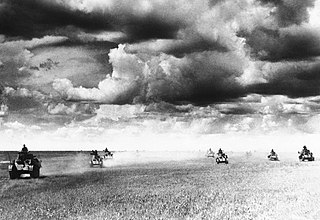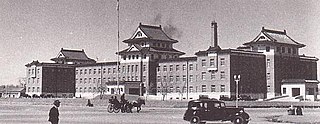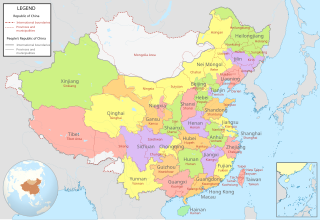
Manchukuo was a puppet state of the Empire of Japan in Northeast China that existed from 1932 until its dissolution in 1945. It was ostensibly founded as a republic, its territory consisting of the lands seized in the Japanese invasion of Manchuria; it was later declared to be a constitutional monarchy in 1934, though very little changed in the actual functioning of government. Manchukuo received limited diplomatic recognition, mostly from states aligned with the Axis powers, with its existence widely seen as illegitimate.

The Second Sino-Japanese War was the war fought between the Republic of China and the Empire of Japan from 1937 to 1945 as part of World War II. It is often regarded as the beginning of World War II in Asia. It was the largest Asian war in the 20th century and has been described as "the Asian Holocaust", in reference to the scale of Japanese war crimes against Chinese civilians. It is known in Japan as the Second China–Japan War, and in China as the Chinese War of Resistance against Japanese Aggression.

Huang Xing or Huang Hsing was a Chinese revolutionary leader and politician, and the first commander-in-chief of the Republic of China. As one of the founders of the Kuomintang (KMT) and the Republic of China, his position was second only to Sun Yat-sen. Together they were known as Sun-Huang during the Xinhai Revolution. He was also known as the "Eight Fingered General" because of wounds sustained during war. His tomb is on Mount Yuelu, in Changsha, Hunan, China.

Manchuria is a region in East Asia. Depending on the definition of its extent, Manchuria can refer either to a region falling entirely within present-day China, or to a larger region today divided between Northeast China and the Russian Far East. To differentiate between the two parts following the latter definition, the Russian part is also known as Outer Manchuria, while the Chinese part is known as Northeast China.

The Battle of Changsha of 1944 was an invasion of the Chinese province of Hunan by Japanese troops near the end of the Second Sino-Japanese War. As such, it encompasses three separate conflicts: an invasion of the city of Changsha and two invasions of Hengyang.

The Soviet invasion of Manchuria, formally known as the Manchurian Strategic Offensive Operation or simply the Manchurian Operation, began on 9 August 1945 with the Soviet invasion of the Japanese puppet state of Manchukuo. It was the largest campaign of the 1945 Soviet–Japanese War, which resumed hostilities between the Union of Soviet Socialist Republics and the Empire of Japan after almost six years of peace. Since 1983, the operation has sometimes been called Operation August Storm after U.S. Army historian David Glantz used this title for a paper on the subject.
This article is concerned with the events that preceded World War II in Asia.

Operation Ichi-Go was a campaign of a series of major battles between the Imperial Japanese Army forces and the National Revolutionary Army of the Republic of China, fought from April to December 1944. It consisted of three separate battles in the Chinese provinces of Henan, Hunan and Guangxi.

The Soviet–Japanese War, known in Mongolia as the Liberation War of 1945, was a campaign of the Second World War that began with the Soviet invasion of Japanese-occupied territory following the Soviet declaration of war against Japan on 7 August 1945. The Soviet Union and Mongolian People's Republic toppled the Japanese puppet states of Manchukuo in Manchuria and Mengjiang in Inner Mongolia, as well as northern Korea, Karafuto on the island of Sakhalin, and the Kuril Islands. The defeat of Japan's Kwantung Army helped bring about the Japanese surrender and the end of World War II. The Soviet entry into the war was a significant factor in the Japanese government's decision to surrender unconditionally, as it was made apparent that the Soviet Union was not willing to act as a third party in negotiating an end to hostilities on conditional terms.

The Korean Liberation Army, also known as the Korean Restoration Army, was the armed forces of the Provisional Government of the Republic of Korea. It was established on September 17, 1940, in Chongqing, Republic of China, with significant financial and personnel support from the Kuomintang. It participated in various battles and intelligence activities against the Japanese, including alongside the British Army in India and with the United States in the Eagle Project. The group only reached several hundred personnel at its peak, and faced constant funding issues, infighting, and difficulty achieving recognition from global powers.

The Fengtian clique was the faction that supported warlord Zhang Zuolin during China's Warlord Era. It took its name from Fengtian Province, which served as its original base of support. However, the clique quickly came to control all of the Three Northeastern Provinces. The clique received support from Japan in exchange for protecting Japanese military and economic interests in Manchuria. The Fengtian Army frequently intervened in many of the conflicts of the Warlord Era.

The Empire of Japan's Kwantung Army invaded the Manchuria region of the Republic of China on 18 September 1931, immediately following the Mukden Incident. At the war's end in February 1932, the Japanese established the puppet state of Manchukuo. Their occupation lasted until the success of the Soviet Union and Mongolia with the Manchurian Strategic Offensive Operation in mid-August 1945, towards the end of the Second World War.

The Soviet–Japanese border conflicts, also known as the Soviet-Japanese Border War, the First Soviet-Japanese War, the Russo-Mongolian-Japanese Border Wars or the Soviet-Mongolian-Japanese Border Wars, were a series of minor and major conflicts fought between the Soviet Union, Mongolia and Japan in Northeast Asia from 1932 to 1939.

The Republic of China (ROC), commonly now known as Taiwan, was a sovereign state based on mainland China from 1912 to 1949 prior to the government's relocation to Taiwan, where it continues to be based today. The ROC was established on 1 January 1912 during the Xinhai Revolution against the Qing dynasty, ending the imperial history of China. The Republican government was ruled by the Kuomintang (KMT) as a one-party state based in Nanjing from 1927, until its flight to Taipei on 7 December 1949 following the KMT's de facto defeat by the Chinese Communist Party (CCP) in the Chinese Civil War. The CCP proclaimed the People's Republic of China on 1 October 1949, while the ROC retains control over the "Free Area", with the political status of Taiwan remaining in dispute to this day.

The Kwantung Army was a general army of the Imperial Japanese Army from 1919 to 1945.

The history of the administrative divisions of China after 1949 refers to the administrative divisions under the People's Republic of China. In 1949, the communist forces initially held scattered fragments of China at the start of the Chinese Civil War. By late 1949, they controlled the majority of mainland China, forcing the Republic of China government to relocate to Taiwan.
The administrative divisions of China between 1912 and 1949 were established under the regime of the Republic of China government.

Outer Mongolia — officially the Mongolian People's Republic — was ruled by the communist government of Khorloogiin Choibalsan during the period of World War II and had close links with the Soviet Union. Most countries regarded Mongolia, with its fewer than a million inhabitants, as a breakaway province of the Republic of China. Throughout the 1941–1945 war between Germany and the Soviet Union, Mongolia provided the Soviets with economic support—such as livestock, raw materials, money, food and military clothing—violating Mongolian neutrality in favor of the Allies. Mongolia was one of two Soviet satellite states not generally recognised as sovereign states at the time, along with the Tuvan People's Republic; both of these republics participated in World War II.

















